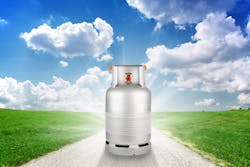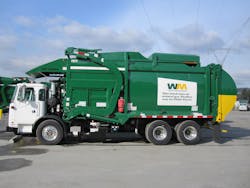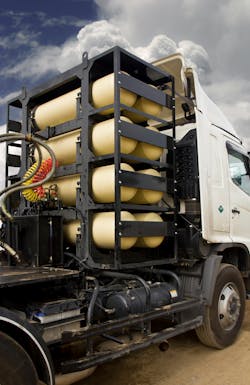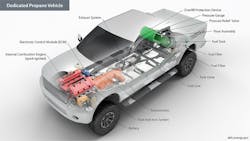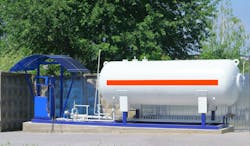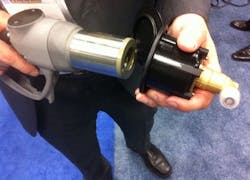Natural gas- and propane-powered vehicles: Still a smart move?
What you will learn:
• The motoring public are struggling to grasp the use of propane and natural gas as a fuel source.
• Both fuels can be extremely beneficial if the infrastructure is in place
• Vehicle fleets will benefit most economically from implementing these fuels
Natural gas and propane-powered vehicles have been in existence for decades, but they just can’t seem to get out of the starting gate. Their popularity has ebbed and flowed throughout the 2000s, with usage seemingly tied directly to the cost of gasoline and diesel. When gas prices go up, everyone rushes to less expensive fuels such as the gaseous ones, and the opposite happens when gas prices drop.
However, even during eras when gaseous-fueled vehicles were the most popular, their use was primarily represented by fleets and municipalities. Why the lack of adoption from the light-duty consumer? Mainly, it's due to the lack of fueling infrastructure. Gaseous fueling stations exist, with thousands of them located nationwide. However, these stations are primarily the sole property of fleets and are not available for use by the general public, hence the roadblock. Consumers are not likely to purchase an alternative fuel grocery-getter if they aren’t confident in their ability to put fuel in the tank.
Looking at medium and heavy-duty gaseous fuel vehicle usage, their popularity has stayed relatively consistent for non-consumer fleets. According to the U.S. Department of Energy’s Alternative Fuel Data Center, natural gas powers over 175,000 vehicles in the United States, and propane powers about 60,000. Those are not very large numbers for a country with just shy of 290 million vehicles on our roadways, but there has been steady growth. They are a wise choice for fleets with large fuel usage volumes to justify the cost of a propane or natural gas fueling station.
The fuel savings are actual. At the end of 2021, compressed natural gas vehicle fuel averaged $2.25 per gallon, with propane averaging around $3.10. That may not seem like significant savings over gasoline or diesel, but when you consider the volume of fuel that a fleet of vehicles go through (such as refuse trucks, buses, and delivery vehicles), fuel-savings such as this makes the switch to propane or natural gas an attractive alternative.
Although electric vehicle sales have outpaced gaseous fuels in light-duty vehicles, electric vehicles (EVs) are still sorely lacking in their current development cycle for the applications where gaseous fuel vehicles excel. Today, vehicle range, high-voltage (HV) battery size and weight, and charging times make it difficult for EVs to compete with what a propane or natural gas vehicle can do for medium and heavy-duty use, but the gap is closing.
Although these two gaseous fuels are somewhat similar in fuel properties and system design and are frequently grouped together (like in this article), they are distinctly different. Therefore, this article will discuss each separately, presenting the capabilities of each along with their advantages and disadvantages.
Natural gas
Natural gas is the simplest of all hydrocarbons, with methane being the principal constituent of natural gas. Methane has the chemical formula CH4, which means that each molecule has four hydrogen atoms and one carbon atom. This atomic simplicity is why natural gas is such a clean-burning fuel. Although it can be used in light-duty consumer vehicles, the last CNG car available for purchase in the United States was the CNG Honda Civic, which ended production in 2015 after selling only 15,000 cars. Most of those went to fleets and taxi services. Right now (as far as I know), there are no light-duty natural gas vehicles available for sale in the U.S. Instead, these light-duty vehicles are outfitted by companies to either become a dedicated (natural gas only) vehicle or a bi-fuel vehicle that can operate on either natural gas or gasoline.
CNG vs. LNG
Natural gas can be used in a vehicle in two different forms: compressed natural gas (CNG) and liquefied natural gas (LNG).
Compressed natural gas is aptly named. CNG vehicles have a fuel tank that holds natural gas compressed to a maximum pressure of 3600 psi to give the best range possible for the size of fuel tank the vehicle may have. With most commercial fueling stations, they can fill their tanks almost as fast as a gasoline vehicle, but these “fast-fill” stations are costly, with large implementations costing millions of dollars. However, for operations with a fixed usage cycle such as refuse trucks and “point-to-point” deliveries, a less expensive fueling structure commonly referred to as “time-fill” can be used to refuel the vehicle overnight while the vehicle is not in operation (Figure 1-4).
Chilling natural gas to –259 degrees F (–162 degrees C) creates LNG. Chilling increases the energy content of natural gas and extends vehicle range through a more efficient storage volume, making it an attractive truck or bus fuel compared to CNG. Almost all other hydrocarbon and inert gases separate from natural gas in the cryogenic chilling process, leaving pure methane. LNG, however, does have its drawbacks. LNG fueling stations are costly to construct, and due to the chilling nature of the fuel, a fueled LNG vehicle will, over time, vent unused fuel to the atmosphere as the liquid fuel warms, turns to gas, and is released from the fuel tank as pressure builds. Over-the-road trucks that travel long distances are the primary users of LNG systems, as the need to carry as much fuel as possible and long drive times can make it a suitable fuel choice.
Natural gas fuel system types
There are three variations of CNG fueling systems ideal for different situations: dedicated, bi-fuel, and dual-fuel.
Dedicated: Vehicles that operate on only one fuel, natural gas
Bi-fuel: Vehicles that have two separate parallel fueling systems, enabling them to run on either natural gas or gasoline
Dual-fuel: A heavy-duty truck fueling system that operates on diesel but “blends” natural gas with the diesel for lower emissions and fuel cost
As you can readily see, each of these fuel system configurations has an ideal segment in the transportation market. A dedicated system will give the vehicle operator the most extensive fuel-saving opportunities, as they operate on CNG only. A bi-fuel system would be ideal for a vehicle that works in areas where there may or may not be CNG fueling available and can then operate on gasoline until CNG is available. Dual-fuel research and testing are ongoing for the heavy-duty tractor-trailer market. These vehicles blend CNG and diesel in a conventional compression-ignited diesel engine, replacing as much diesel as possible with a lower-cost and cleaner-burning gaseous fuel.
LNG systems are capable of both dedicated and dual-fuel capability.
Advantages of natural gas vehicles
Fuel cost is the main advantage. As stated above, natural gas as a fuel is significantly less expensive than gasoline and diesel, making it an excellent economical choice for those who purchase a lot of fuel. Other significant advantages are a much cleaner burning engine with reduced emissions and lower vehicle maintenance, as the cleaner-burning fuel leaves fewer deposits inside the engine. In addition, the United States has an extremely large reserve of natural gas deposits within our borders, providing energy independence and a more stable fuel pricing matrix. As for the vehicles themselves, just a few years ago, natural gas vehicles were all "outfitted" by companies that converted traditionally fueled vehicles to operate on natural gas. Today, companies like Freightliner offer direct sales of natural gas trucks, and Cummins, a leader in heavy-duty engines, provides a line of natural gas engines used by many manufacturers such as Volvo for their heavy-duty trucks.
Disadvantages of natural gas vehicles
The primary disadvantages reside in the availability of fueling stations and the special needs of the vehicles themselves. The fueling stations, once installed, do require maintenance and training to keep them operational. There is also a need for technician and driver training, as the vehicles require a different level of diagnostic, repair, and operation instruction.
Propane
Propane, called “propane autogas,” when used as a vehicle fuel, is a colorless, odorless, heavier-than-air gas that, when compressed, can be stored as a liquid. Liquefied petroleum gas (LPG), commonly referred to as propane, is a high-energy alternative fuel familiar to most people, especially those who use it to heat their homes. However, propane can be used for more than just home heating and cooking.
Propane autogas has been in use since the 1920s as fuel for light-duty and heavy-duty vehicles (Figure 5). Today, three percent of propane produced is used as a transportation fuel. Nearly all the United States propane autogas is produced domestically. More than half (55 percent) of the propane autogas produced is a byproduct from natural gas purification (from wet gas wells), and the rest (45 percent) is from crude oil refining.
When stored in a vehicle as fuel, propane is contained at a relatively low pressure of 170 psi, or about twice the pressure of a tractor-trailer truck tire. Compared to other gaseous fuels, this relatively low pressure gives propane an advantage, as vehicle fueling stations are relatively inexpensive to install, and vehicles using propane can be fueled quickly.
Although there are no light-duty propane vehicles available directly from an original equipment manufacturer (again, as far as I know), many aftermarket conversion companies convert gasoline vehicles to partial or total operation on propane. In addition, companies such as ICOM North America and Alliance AutoGas produce and sell EPA and CARB certified conversion kits for all types of transportation equipment that can be installed in-house with a bit of training.
Propane fuel system types
Like natural gas, there are three variations of propane fueling systems ideal for different situations: dedicated, bi-fuel, and dual-fuel.
Dedicated: Vehicles that operate on only one fuel, propane
Bi-fuel: Vehicles that have two separate parallel fueling systems, enabling them to run on either propane or gasoline
Dual-fuel: A heavy-duty truck fueling system that operates on diesel but “blends” propane with the diesel for lower emissions and fuel cost
Again, just like natural gas, each of these fuel systems has an ideal segment in the transportation market. Unless a vehicle purchaser has direct access to a propane fueling station, most operators choose the bi-fuel configuration to prevent the “range anxiety” of seeking a propane fueling station when running low. In addition, the dual-fuel systems are explicitly used in the Class 8 tractor-trailers to replace diesel in compression-ignited engines, reducing emissions and lowering fuel costs.
Advantages of propane
Propane only contains (per gallon), about 80 percent of the same BTUs as gasoline, but this lower energy coefficient does not prevent propane from being a lower-cost fuel. It also is a clean-burning fuel and can be easier on internal combustion engine components. However, propane’s most significant advantage over natural gas as a fuel source is the low cost of setting up a fueling station. A “skid” type tank and dispenser can often be purchased and delivered for less than the price of the vehicle it will fuel (Figure 6).
Disadvantages of propane
Propane-powered vehicles can have a shorter range than gasoline vehicles, due to the lower BTU value of the fuel. Also, any cost savings related to lower fuel pricing needs to be evaluated with the cost of the vehicle conversion. Another concern for bi-fuel vehicles is the propane tank’s location, which is often placed in the bed of a pickup or in the trunk of a car, which reduces payload capability.
So, why aren’t there more gaseous fueled vehicles on the road?
Good question.
Many analysts say it is a perfect example of “the chicken and the egg.” Consumers say they want gaseous fueled vehicles, but there aren’t any available that are ready to go directly from a manufacturer. Additionally, they cite the lack of public fueling stations (Figure 7). On the other side of the fence, commercial businesses that sell vehicles and install fueling stations say that they can’t invest in the cars and fueling infrastructure because there is no consumer demand.
NGVAmerica, one of our country’s leading advocates for natural gas vehicles, states that natural gas vehicle usage is steadily growing, especially in the heavy-duty truck arena, and is an intelligent choice from an environmental standpoint. In addition, when using renewable natural gas, a form of fuel produced naturally from municipal solid waste landfills, water resource recovery facilities, livestock farms, food production facilities, and organic waste management operations, the fuel has a lower environmental impact than an equivalent electric vehicle— heady stuff.
Another advantage we briefly touched on earlier is the abundant natural gas supply here in the United States. The U.S. is the world’s number one natural gas producer, with an estimated supply in the ground to cover the next 100 years. So, if energy independence is high on your list of priorities, that is some food for thought.
As for propane, let’s turn to the Propane Education and Research Council (PERC), which promotes a variety of advantages for the use of propane, especially in the fleet marketplace. Propane fueling is easy, comparable to gasoline and diesel, simplifying operator training. PERC also promotes statistical data on longer propane vehicle uptime and lower repair costs, especially when compared to diesel vehicles. Finally, just like CNG, propane as a motor fuel has a lower environmental impact than the fuels it strives to replace and is a domestically produced energy source.
These sources could be considered biased, as they promote their specific vehicle fuel, but the information presented is factual. Both fuels have distinct advantages over gasoline and diesel. They are targeting the commercial medium and heavy-duty market as electric vehicles have effectively pushed them out of the consumer daily-driver arena. Fleets looking to lower per-mile fuel costs while simultaneously reducing emissions, shrinking vehicle maintenance budget, and wishing to promote renewable energy, in the case of RNG, should look to these options. Setting up a maintenance shop for gaseous vehicles isn’t simple and can be the most significant challenge to move into this type of vehicle. Technician training is readily available, and so is the support of the companies selling or outfitting the vehicles. With medium and heavy-duty electric vehicles still in the developmental and testing phase, an intense look at natural gas and propane may be wise for your small or large fleet.
About the Author
Micheal Smyth
Micheal Smyth is a founding partner and Director of Training for AFV Educate, a not-for-profit 401(c)(3) training organization specializing in alternative fuel curriculum development and educational presentation for first and second responders and automotive technicians. His previous positions included Director of West Virginia University’s National Alternative Fuels Training Consortium and Director of Training at Automotive Video Innovations. Mike has over 12 years of experience working with and presenting information on AFVs. Connect with him at LinkedIn.
